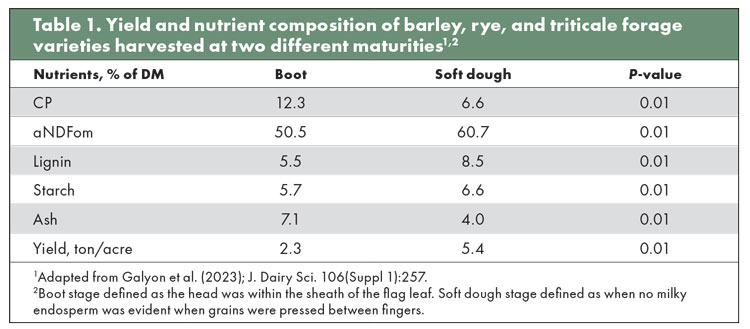
High-quality forages are vital for dairy farm productivity and sustainability. This was evident in many presentations at the annual meeting of the American Dairy Science Association (ADSA). The objective of this article is to describe and discuss some of the forage research; however, these are only a few of the many research trials presented and were hand-picked to represent different areas within forage research.
Producing high-quality small grain forages: Small grain forages continue to rise in popularity in many parts of the United States. These crops have garnered interest for multiple reasons. Many farmers plant small grains primarily as cover crops for improving soil health while reducing erosion and nutrient losses. Conveniently, this also presents the opportunity to produce extra forage. For others, growing small grains is a necessary strategy to stretch forage inventories. But like other forages, the stage of maturity at harvest influences the nutritive value of small grains.
A study conducted in three locations in Virginia assessed maturity at harvest of two barley, two rye, and four triticale varieties. Forages were either harvested at boot stage or at soft dough stage. Overall, concentrations of neutral detergent fiber (NDF), lignin, and starch were lower and ash and crude protein (CP) content was greater when forages were harvested earlier. This improvement in forage quality was at the expense of dry matter yields (Table 1).

Another study conducted by the same group evaluated the effects of feeding triticale silage harvested at boot stage or soft dough stage to dairy cows. The difference between maturities was less pronounced than the study described above. Crude protein was 1.2 percentage units higher, whereas NDF was 2 percentage units lower when triticale was harvested at boot stage. Under these conditions, feeding triticale silage harvested at boot stage improved milk yield by 2.4 pounds per day. However, fat-corrected milk yield and feed efficiency were similar between both treatments.
Defining the ideal harvest maturity of small grains is not an easy task and will be determined by the unique challenges and needs of each dairy farm. Planning ahead in brainstorming sessions between dairy farmers, nutritionists, agronomists, and crop consultants to achieve adequate forage quality and ensure sufficient forage inventory is advised.
Moisture concentration at ensiling is another key factor associated with forage quality, as it affects fermentation patterns and the ability of undesirable microorganisms to thrive in silage. Researchers from Delaware evaluated the efficacy of inoculating direct cut or wilted triticale silage with lactic acid producing bacteria. This type of inoculant speeds up the fermentation process, which reduces the chance of clostridial fermentation that is commonly observed in high-moisture forages. The direct cut triticale was about 74% moisture, whereas the wilted forage was ensiled at 66% moisture. Inoculating triticale silage boosted lactic acid concentration while reducing ammonia accumulation and preventing butyric acid production. Inoculation also curbed enterobacteria counts, but this response was faster on wilted silage than direct cut silage.
The most prevalent mycotoxins in corn silage: Continuing with the discussion about undesirable compounds in forages, mycotoxins could not be left out. Concerns about the presence of mycotoxins in silage intensify in years when environmental conditions during the forage growing season enable mold proliferation. The 2023 growing season is one example as some mycotoxins are more prevalent during hot, dry weather.
A survey presented at the ADSA meeting collected 947 corn silage samples worldwide between September 2022 and February 2023. For full disclosure, this survey was conducted by a private company that commercializes products for mycotoxin detoxification. North America, which included the United States and Canada, accounted for 218 out of 947 samples. The most prevalent mycotoxin in these samples was deoxynivalenol (DON), also known as vomitoxin, with 74% prevalence and an average concentration of 2.5 parts per million (ppm) among positive samples. The presence of 1.5 ppm to 2.5 ppm DON was previously associated with reduced feed consumption and milk production by dairy cows.
The second-most common mycotoxin found in corn silage was zearalenone, which had a 40% prevalence and an average concentration of 0.6 ppm in positive samples. Field observations associated zearalenone with lower milk production and reproductive issues as well as abortion in dairy cows. The maximum zearalenone concentration suggested for heifers and dairy cows is 10 ppm and 25 ppm, respectively.
The implementation of proper harvesting and storage practices is advised to reduce mold proliferation and the risk of mycotoxin development, but keep in mind mycotoxins may occur even when good management practices are applied. Even though silage fermentation has been suggested to reduce the concentration of mycotoxins, recent research suggests this may not always be the case. The issues may even be exacerbated in storage over time.
If the presence of mycotoxins is a concern based on visual spoilage present in the silo, sending samples to a lab for analysis is key. Most importantly, if corn silage has mycotoxins, take action to detoxify the silage by adding a mycotoxin-binding agent to the diet or adopting feeding strategies that dilute the amount of mycotoxins fed with noncontaminated feeds.
This article appeared in the November 2023 issue of Hay & Forage Grower on page 24-25.
Not a subscriber? Click to get the print magazine.

